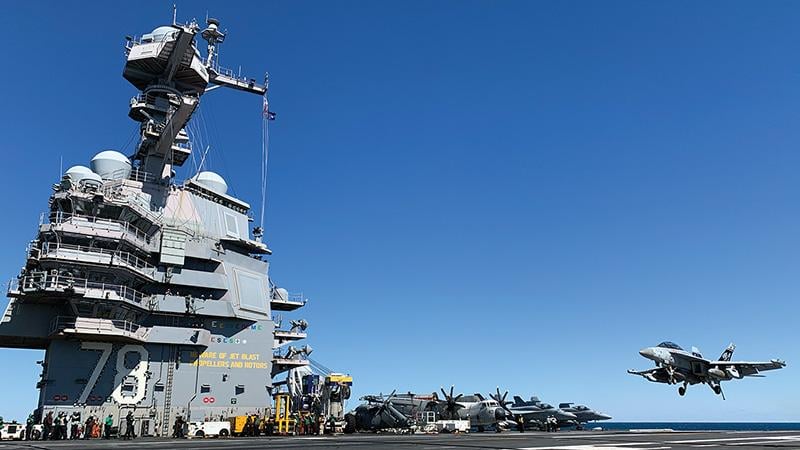This article is published in Aviation Week & Space Technology and is free to read until May 09, 2025. If you want to read more articles from this publication, please click the link to subscribe.
USS Gerald Ford Works Out Its First-In-Class Kinks Ahead Of Deployment

The USS Gerald Ford and its embarked carrier air wing maintain a high pace of flight operations as part of training prior to its next deployment.
The U.S. Navy’s newest aircraft carrier, its complement of strike aircraft and a team of support ships are completing a capstone exercise designed to pit the carrier’s air wing against increasing threats the service has seen in the Middle East.
The USS Gerald R. Ford (CVN 78) Carrier Strike Group’s Composite Training Unit Exercise (Comptuex) is set to wrap up in mid-April off the coast of North Carolina ahead of a deployment expected in the coming months. The Ford embarked on its first full-length deployment to the North Atlantic Ocean in May 2023, and it was repositioned to the Eastern Mediterranean Sea in October 2023 following the Hamas attacks on Israel and subsequent attacks by Iran and the Houthis in Yemen. It returned to its Virginia homeport in January 2024.
- Air defense changes are deploying for the first time in the Atlantic with the Ford-class strike group
- New counter-UAS systems are set to deploy
While the Ford’s first full-length deployment was originally to the Second Fleet’s area of responsibility in the Atlantic and Arctic oceans, the training in the run-up this time is geared toward ongoing operations in areas such as the Red Sea. That is where the deployed USS Harry S. Truman (CVN 75) is conducting daily operations to strike the Houthis in Yemen, and the Defense Department announced a second carrier, the USS Carl Vinson (CVN 70), would also steam in that direction.
“This is a rehearsal, and we’re going to get it right, and that will put us in a good stead as we go forward on this next deployment,” says Capt. Richard Burgess, the Ford’s commanding officer.
The ship is at sea with Carrier Air Wing (CVW) 8 and its nine embarked aviation squadrons: four Boeing F/A-18 strike fighter squadrons, one E/A-18 Growler electronic attack squadron, one Northrop Grumman E-2 airborne command and control squadron, a detachment of C-2s for fleet logistics and two helicopter squadrons. The C-2s, from the Rawhides of Fleet Logistics Support Sqdn. 40, are seeing their service lives extended because the Bell Boeing CMV-22B tiltrotor has not taken on the operational carrier-on-board delivery mission.
Ahead of Comptuex, the aircraft trained at NAS Fallon, Nevada, tailored to the happenings in the Middle East—particularly the ongoing threat of uncrewed aircraft systems (UAS).
“[It is] very agile to adjust the training to make sure we’re fully equipped to understand the battle space and what we’re going to get into,” says Capt. David Dartez, CVW 8’s commander.
While Dartez would not mention specifics, he says tactics and procedures have been adjusted to strike fighter operations to counter UAS. One major change has been the adoption of the “Murder Hornet” configuration of the F/A-18, which has the aircraft fully loaded with four AIM-9X and five AIM-120 missiles to down drones. Other changes to operations in the Red Sea include increasing the maximum landing weight of the F/A-18 to limit wasted fuel as well as using the EA-18 for air-to-air engagements with the AIM-9X.
“Some of these aircraft, some of these sailors might go into harm’s way, and we need to make sure that they’re prepared,” he says.
With an increased focus on aircraft readiness across the Navy, the service has prioritized maintaining an F/A-18 mission-capable rate of more than 80%. The Super Hornet squadrons with CVW 8 are currently operating “well above any standard across the Navy” amid Comptuex, Dartez says.
A major change for the Ford Carrier Strike Group’s deployment is using a guided missile destroyer to command air defenses, a role typically handled by Ticonderoga-class cruisers that are being retired. Capt. Mark Lawrence, the commodore of Destroyer Sqdn. 2, says the Flight IIA standard destroyer USS Winston S. Churchill (DDG 81) has been modified and will be the first to deploy for the role in the Atlantic.
The Churchill will carry Raytheon Coyote and Anduril Roadrunner counter-UAS systems, along with the proven yet expensive Standard Missile-2 and Aegis systems for air defense. The ships also train to use less expensive guns for counter-UAS.
While the $13 billion Ford, the Navy’s newest carrier, has deployed before, the ship still has extensive development issues. The latest Pentagon Director of Operational Test & Evaluation report outlined sortie generation issues with the Ford’s new Electromagnetic Aircraft Launch System (EMALS) and Advanced Arresting Gear (AAG), along with ongoing effectiveness issues with its advanced weapons elevators, dual-band radar and quality of life issues, such as not enough berthing for crew. The EMALS and AAG have proven effective and agile, officials say. For example, through software, the ship is able to change arresting cable retraction times to speed up landing operations.
The biggest long-term issue for the Ford class is that it is not yet cleared to operate the Lockheed Martin F-35. The biggest priority for crews now is completing Comptuex and being ready to deploy.
“This ship is extraordinary,” Burgess says. “There were problems in the past, but it’s also an obligation for a first-in-class ship to identify the things that need to be improved.”






Comments
First deployment is where most of the growth takes place, and assumptions now turn into demonstrated capability . . . resulting in even greater improvements.